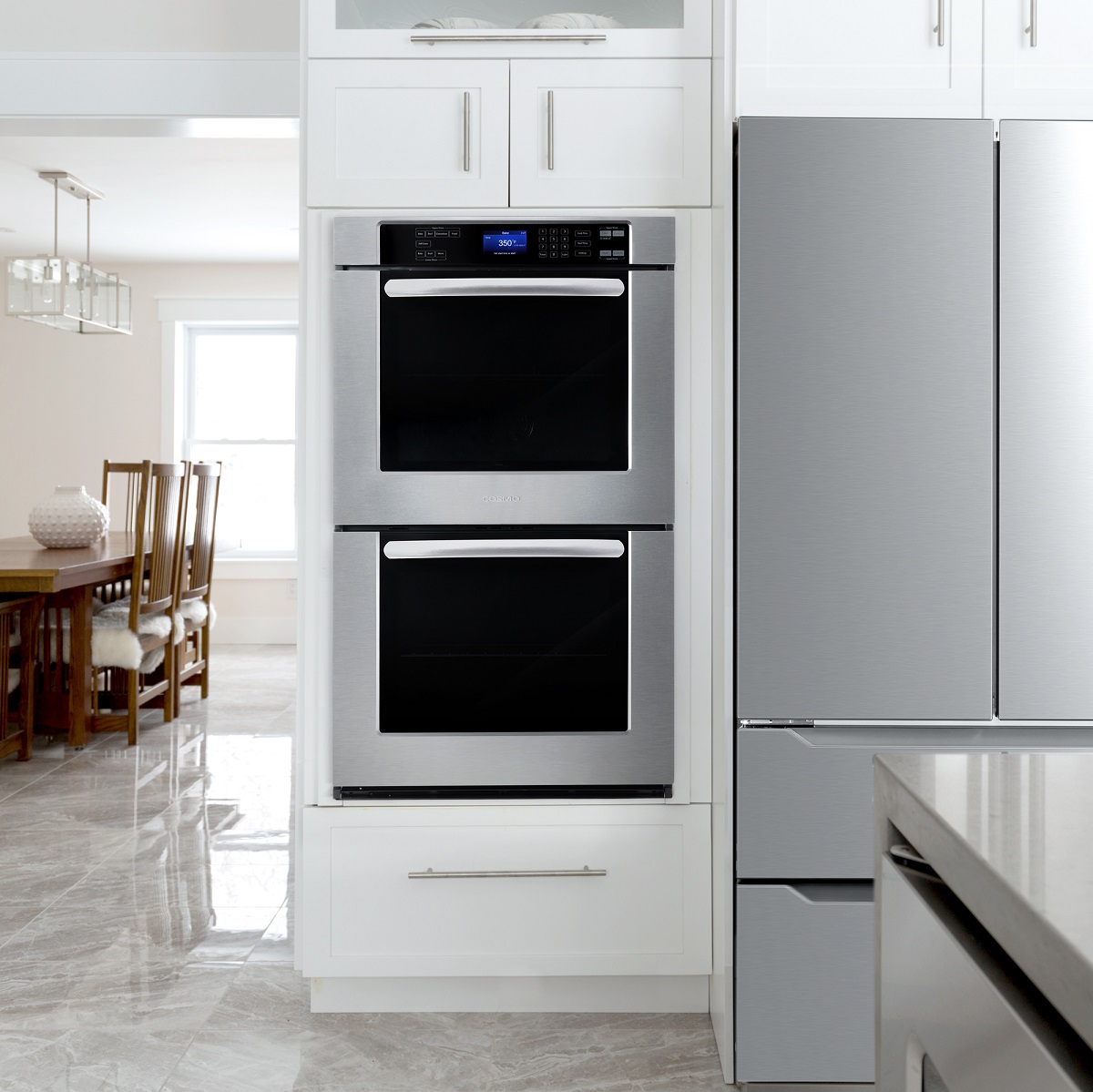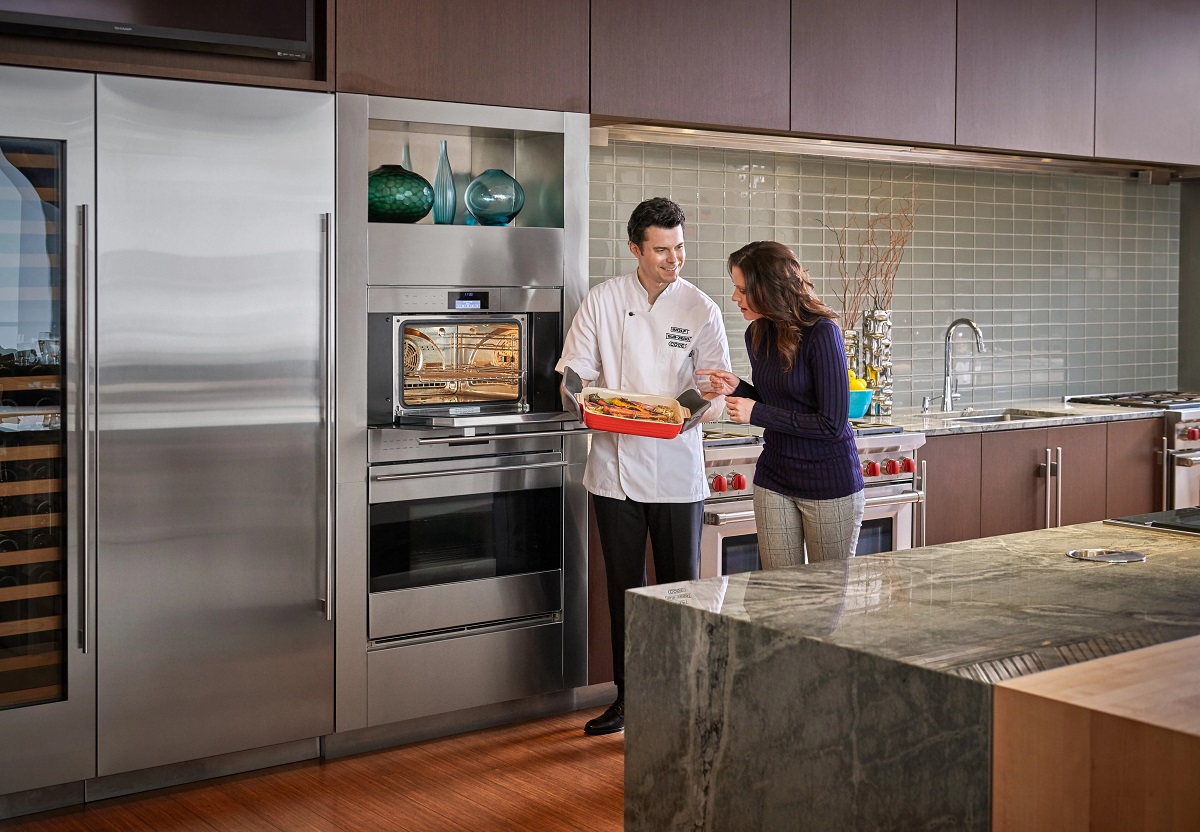

Articles
How Are Wall Ovens Measured
Modified: August 28, 2024
Learn how articles on measuring wall ovens can help you find the perfect fit. Discover key insights and tips for accurate measurements.
(Many of the links in this article redirect to a specific reviewed product. Your purchase of these products through affiliate links helps to generate commission for Storables.com, at no extra cost. Learn more)
Introduction
When it comes to kitchen appliances, wall ovens have become a popular choice for homeowners. With their sleek design and convenient placement at eye level, wall ovens offer a practical and stylish solution for baking and cooking needs. However, before embarking on the journey of purchasing a wall oven, it is important to understand the measurements involved. In this article, we will explore the standard measurements of wall ovens and how to accurately measure for one in your kitchen.
Choosing the right wall oven requires taking precise measurements to ensure a proper fit. It is crucial to have accurate measurements of the width, height, and depth of the designated space in your kitchen. By following the correct measurement process, you can confidently select a wall oven that seamlessly integrates into your kitchen cabinetry and provides efficient cooking capabilities.
So, without further ado, let’s delve into the world of wall oven measurements and discover the key factors to consider when finding the perfect fit for your kitchen.
Key Takeaways:
- Ensure a perfect fit for your wall oven by accurately measuring width, height, and depth. Consider clearance, ventilation, and electrical requirements for a seamless installation and optimal functionality.
- Don’t overlook important factors like door swing direction and accessibility needs when measuring for a wall oven. Follow manufacturer’s specifications for precise measurements and a successful kitchen upgrade.
Read more: How Deep Are Wall Ovens
Standard Wall Oven Measurements
Before we dive into the details of measuring for a wall oven, let’s first understand the standard measurements that most wall ovens adhere to. While individual models may vary slightly, these measurements can serve as a general guideline:
- Width: Most wall ovens have a standard width of 24, 27, or 30 inches. However, there are also wider options available, such as 36 inches, for those seeking more cooking capacity.
- Height: The standard height for wall ovens typically ranges from 28 to 50 inches. Again, keep in mind that there may be variations depending on the specific model.
- Depth: Wall ovens usually have a depth of around 24 to 26 inches. This measurement includes the oven door and handle, so be aware of any protrusions that may affect your kitchen layout.
It is essential to note that these measurements are just a starting point. Always refer to the manufacturer’s specifications for the specific wall oven you are considering, as there may be variations that deviate from the standard dimensions.
Additionally, keep in mind that wall ovens can come in different configurations, such as single or double ovens. Single ovens are typically installed alone, while double ovens are stacked on top of each other. The measurements for double ovens can vary depending on the configuration you choose, so be sure to take this into account when planning your kitchen layout.
Now that we have a general idea of the standard measurements, let’s move on to the process of measuring for a wall oven in your kitchen.
Measuring Width
When measuring for the width of a wall oven, it is crucial to accurately determine the available space in your kitchen. Here’s a step-by-step guide to help you measure the width:
- Clear the area: Before starting the measurement process, make sure the designated space is clear of any obstacles or appliances.
- Measure the width of the cabinet opening: Using a tape measure, measure the width of the cabinet opening that will house the wall oven. Measure from the inside edges of the cabinet, where the oven will be installed.
- Take into account extra space: Keep in mind that wall ovens require some clearance on each side for proper installation and ventilation. Refer to the manufacturer’s specifications to determine the required amount of clearance. Typically, you should leave about 1-2 inches of clear space on each side.
- Consider the trim: If your cabinets have decorative trim or molding, be sure to account for this when measuring the width. Measure from the inside edges of the trim for a more accurate measurement.
It is essential to measure the width with precision to ensure a proper fit for the wall oven. Remember to double-check your measurements and take into account any additional space requirements specified by the manufacturer.
Now that we have covered the width measurement, let’s move on to measuring the height of the wall oven in the next section.
Measuring Height
Measuring the height for a wall oven is an important step to ensure a proper fit in your kitchen. Follow these steps to accurately measure the height:
- Clear the area: Before beginning the measurement, remove any items or obstructions from the space where the wall oven will be installed.
- Measure the height of the cabinet opening: Using a tape measure, measure the height of the cabinet opening from the inside top to the inside bottom. Be sure to measure from the back wall of the cabinet to the front edge.
- Account for extra space: Wall ovens typically require some clearance between the oven and the cabinet above it. Refer to the manufacturer’s specifications to determine the required amount of clearance. You may also need to consider the height of any hinges or trim on the oven.
- Consider the flooring: Take into account the height of your kitchen flooring. If your kitchen has tiles or other types of flooring that may affect the height, measure from the finished floor to the desired height for the oven.
Remember to measure carefully and accurately, taking into account any additional space requirements specified by the manufacturer. By doing so, you can ensure that the wall oven fits perfectly within the designated space.
Now that we have covered how to measure the height, let’s move on to measuring the depth of the wall oven in the next section.
When measuring for a wall oven, be sure to measure the height, width, and depth of the cabinet cutout where the oven will be installed. Take accurate measurements to ensure the new oven will fit properly.
Measuring Depth
Measuring the depth of a wall oven is crucial to ensure that it fits seamlessly into your kitchen cabinets. Here’s a step-by-step guide to help you measure the depth accurately:
- Clear the area: Before you begin measuring, clear the space where the wall oven will be installed. Remove any items or obstructions that may hinder accurate measurements.
- Measure the cabinet depth: Using a tape measure, measure the depth of the cabinet where the wall oven will be installed. Measure from the back wall of the cabinet to the front edge.
- Account for the oven door and handle: Keep in mind that the depth measurement should include the oven door and handle. Some ovens have protruding handles, so make sure to factor that into your measurement. Refer to the manufacturer’s specifications for the specific oven model to obtain the accurate measurement.
- Consider any back wall space needed: Some wall ovens may require additional space at the back for proper ventilation. Refer to the manufacturer’s specifications to determine if any extra space is needed behind the oven.
Accurate measurement of the depth is crucial to ensure that the wall oven fits properly within the designated space. Take into account the oven door, handle, and any extra clearance specified by the manufacturer to achieve the perfect fit.
Now that we have covered how to measure the depth, let’s move on to discussing important considerations for wall oven measurement.
Read more: How Wide Are Wall Ovens
Important Considerations for Wall Oven Measurement
When measuring for a wall oven, there are a few important considerations to keep in mind to ensure a successful installation and optimal functionality. Here are some key factors to consider:
- Electrical requirements: Before purchasing a wall oven, make sure to check the electrical requirements for the specific model you are interested in. Consider the voltage and amperage requirements to ensure that your kitchen’s electrical system can support the oven.
- Ventilation requirements: Wall ovens require proper ventilation to dissipate heat during cooking. Refer to the manufacturer’s specifications to understand the ventilation requirements for the oven. Ensure that your kitchen space allows for adequate ventilation, either through natural airflow or by installing a ventilation system.
- Cabinet modifications: If you are replacing an existing wall oven, check if any modifications need to be made to the cabinet. This includes ensuring that the cabinet can support the weight of the new oven and making any necessary adjustments to accommodate the new dimensions.
- Door swing direction: Consider the direction in which the oven door swings open. Ensure that there is enough clearance for the door to open fully without obstruction from nearby walls, cabinets, or appliances.
- Accessibility: If you have specific accessibility needs, such as requiring a lower oven placement for easy reach, take this into consideration when measuring and selecting a wall oven.
By taking these important considerations into account, you can ensure that the wall oven you choose not only fits perfectly into your kitchen but also meets your electrical and ventilation requirements, and offers convenient accessibility.
Now that we have covered the important considerations, let’s conclude our discussion on wall oven measurement.
Conclusion
Accurate measurement is crucial when it comes to selecting and installing a wall oven in your kitchen. By following the steps outlined in this article, you can ensure a proper fit and seamless integration of the wall oven into your kitchen cabinetry. Remember these key points:
- Standard wall oven measurements include width, height, and depth. However, it is always important to refer to the manufacturer’s specifications for the specific oven you are considering.
- When measuring the width, take into account the clearance required on each side of the oven.
- When measuring the height, consider the required clearance above the oven and the height of your kitchen flooring.
- When measuring the depth, include the oven door and handle, and check if any additional ventilation space is required.
- Important considerations for wall oven measurement include electrical requirements, ventilation needs, cabinet modifications, door swing direction, and accessibility requirements.
By carefully measuring for your wall oven and considering these factors, you can ensure a successful installation and create a functional and aesthetically pleasing kitchen space. Remember to consult the manufacturer’s specifications for the specific oven model you are interested in to ensure accurate measurements.
Now that you are armed with the knowledge of wall oven measurements, you can confidently embark on your search for the perfect wall oven that meets your cooking needs and complements your kitchen design. Happy measuring and happy cooking!
Frequently Asked Questions about How Are Wall Ovens Measured
Was this page helpful?
At Storables.com, we guarantee accurate and reliable information. Our content, validated by Expert Board Contributors, is crafted following stringent Editorial Policies. We're committed to providing you with well-researched, expert-backed insights for all your informational needs.















0 thoughts on “How Are Wall Ovens Measured”